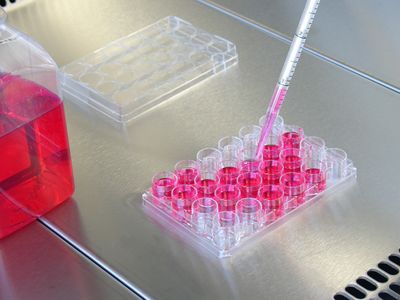ABOVE: © ISTOCK.COM, spawns
What do chemotherapy, dialysis, blood transfusions, stents, strokes, and SARS-CoV-2 infection have in common? All of these technologies and illnesses require circulating blood. But the seemingly intuitive and familiar ideas that the circulation of blood can be a powerful therapeutic ally, a vital contributor to health, and a mechanism of disease took more than 2,000 years to fully develop. When the significance of the human circulatory system was finally established, it revolutionized the life sciences and ushered in modern medicine.
Like Newton’s laws of motion and Darwin’s theory of evolution, the scientific appreciation of the blood’s circulation benefited heavily from the contributions of a single individual, the English physician William Harvey, who in 1628 published De Motu Cordis (the full title of the book is Exercitatio Anatomica de Motu Cordis et Sanguinis in Animalibus [Anatomical Exercise About the Movement of the Heart and Blood in Animals]). In my recently published book, The Wine-Dark Sea Within: A Turbulent History of Blood, I dissect the evolution of the idea that a life-giving fluid courses within us, from the ancient Greeks to the Scientific Revolution to today.
The Greeks observed the ebb and flow of tides in the Aegean Sea (which Homer called the “wine-dark sea”) and inferred that a similar to-and-fro motion of blood operated within the human body. That basic concept, with some modifications, prevailed for 15 centuries. In the 2nd century CE, the influential Roman physician Galen added that blood was continually formed by the liver and delivered to the organs like an irrigation system where it was subsequently consumed completely, with nothing to return. There was no need for circulation.

A foundational discovery that helped Harvey build the model of blood circulation was the new demonstration by his teacher Hieronymus Fabricius of anatomical valves in the veins. Through careful ligature experiments on fish, snakes, and other animals, Harvey showed that these little doors opened and shut in such a way that blood could only flow one way through the veins, from the periphery toward the heart. Hence, he concluded, blood had to return to the heart. What clinched the discovery, in addition to Harvey’s recognition of the valves’ importance in maintaining circulation, was his unprecedented application of quantitative reasoning in the life sciences through a unique thought experiment. By measuring the volume of blood in the left ventricle of the human heart (about 2 ounces) and then calculating the volume ejected per beat, per minute, and per hour, he estimated that an absurd 8,640 ounces or 540 pounds of blood would be manufactured in the liver and used up by the organs every hour if Galen’s model were correct. But even in the face of concrete evidence, old ideas die hard. For centuries, academics had justified their positions by experimenting, writing, and teaching in terms of Galen’s concept of blood flow. That edifice would crumble overnight and their livelihoods would be threatened if Harvey’s discoveries were accepted.
Intellectual confrontations raged throughout Western Europe and in the New World between Galen’s supporters and those who endorsed Harvey. Harvey’s defenders included giants of the British intellectual world: Robert Boyle (of Boyle’s law), Robert Hooke (of Hooke’s law), the philosophers Thomas Hobbes and John Locke, and others. Benjamin Franklin also supported Harvey’s concept of circulation, as did the French chemist Antoine Lavoisier. Harvey’s opponents included the French thinkers René Descartes and Jean Riolan the Younger.
Despite its slow acceptance, Harvey’s discovery that blood circulated was a true paradigm shift, a game changer. His hydraulic description of circular blood flow—out from the heart through the arteries and back to the heart through the veins—laid the groundwork for our modern models of physiological and pathophysiological phenomena, including blood velocity, vascular resistance, blood pressure, and so on. It followed, too, that diseases could arise from insufficient blood flow to vital organs because of obstructions within arteries.
The Greeks observed the ebb and flow of tides in the Aegean Sea (which Homer called the “wine-dark sea”) and inferred that a similar to-and-fro motion of blood operated within the human body.
Modern medicine would be impossible without Harvey’s discovery. Only after accepting the phenomenon of blood circulation could therapies be developed to take advantage of this transport throughout the body, allowing medicines to be administered intravenously (as in chemotherapy and transfusions), subcutaneously (like insulin shots), or as nasal sprays. Routine interventions such as heart catheterizations and stent placements within arteries, as well as the flotation of pacemaker and defibrillator electrodes through veins, would be unthinkable without circulation, as they require the unidirectional flow of blood through arteries and veins as described by Harvey.
Extending the concept of an internal circulation to outside the body as extracorporeal circulation is the basis for lifesaving support systems such as dialysis, the heart-lung machine for open heart surgeries, and heart assist devices, such as the artificial heart. Accurate invasive and noninvasive measurements of heart pump function and blood flows, as well as the development of drugs that influence the mechanisms of the failing heart and circulation, are the lifeblood of our multibillion-dollar medical technology and pharmaceutical industries.
For most readers, The Wine-Dark Sea Within will be a very personal story. Whether they were previously aware of this fascinating history or not, countless people who have received stents or had heart bypass surgery are alive because of Harvey’s discovery of circulation. I, too, am a benefactor of Harvey’s hard work and insight. I had coronary bypass surgery 25 years ago. My personal experience was one of the things that compelled me to write this chronicle of the discovery that keeps many of us alive.
Dhun Sethna is a cardiology specialist at the Carilion Clinic in Virginia. He has served as a clinical and academic cardiologist on the senior academic staff at major medical centers including the Cleveland Clinic and Cedars Sinai Medical Center. He contributed to Braunwald’s Heart Disease: A Textbook of Cardiovascular Medicine.







